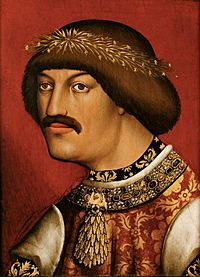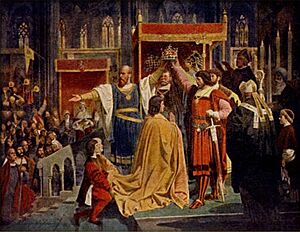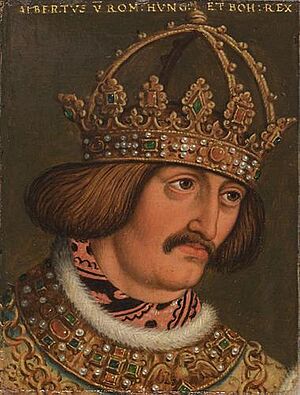Albert II of Germany facts for kids
Quick facts for kids Albert the Magnanimous |
|
|---|---|

Posthumous anonymous portrait of Albert, 16th century
|
|
| Duke of Austria | |
| Reign | 14 September 1404 – 27 October 1439 |
| Predecessor | Albert IV |
| Successor | Ladislaus the Posthumous |
| King of Hungary and Croatia (jure uxoris) | |
| Reign | 18 December 1437 – 27 October 1439 |
| Coronation | 1 January 1438, Székesfehérvár |
| Predecessor | Sigismund |
| Successor | Vladislaus I |
| King of the Romans | |
| Reign | 18 March 1438 – 27 October 1439 |
| Predecessor | Sigismund |
| Successor | Frederick III |
| King of Bohemia | |
| Reign | 6 May 1438 – 27 October 1439 |
| Coronation | 29 June 1438, Prague |
| Predecessor | Sigismund |
| Successor | Ladislaus the Posthumous |
| Born | 10 August 1397 Vienna, Austria |
| Died | 27 October 1439 (aged 42) Neszmély, Hungary |
| Burial | Székesfehérvár |
| Spouse | Elizabeth of Luxembourg |
| Issue | Anne, Duchess of Luxembourg Elisabeth, Queen of Poland Ladislas the Posthumous |
| House | Habsburg |
| Father | Albert IV, Duke of Austria |
| Mother | Joanna Sophia of Bavaria |
| Religion | Roman Catholic |
Albert the Magnanimous, also known as Albert II, was an important king in the 1400s. He was born on August 10, 1397, and died on October 27, 1439. He was a member of the powerful House of Habsburg family.
Albert became the Duke of Austria as Albert V through his family. Later, because of his marriage, he also became the King of Hungary, Croatia, and Bohemia. He was also chosen to be the King of the Romans, a title that often led to becoming the Holy Roman Emperor.
Contents
Biography
Early Life and Becoming Duke
Albert was born in Vienna, which is in Austria. His parents were Albert IV, Duke of Austria, and Joanna Sophia of Bavaria.
When his father died in 1404, Albert was only seven years old. He became the Duke of Austria. Because he was so young, his uncle, Duke William, helped rule as a regent. A regent is someone who governs a country when the king or ruler is too young or unable to rule.
After Duke William, his other uncles, Leopold IV and Ernest the Iron, also served as regents. There were some disagreements and even small wars between his uncles as they tried to control the land.
Despite these challenges, Albert received a good education. When he turned 14 in 1411, he took full control of Austria. With the help of his advisors, he worked hard to fix the problems that had appeared during his childhood.
Marriage and New Kingdoms
In 1422, Albert married Elisabeth of Luxemburg. She was the daughter of King Sigismund of Hungary. Sigismund later also became the Holy Roman Emperor and King of Bohemia.
This marriage was very important for Albert. It meant he could claim the thrones of several other kingdoms, including Hungary and Bohemia.
Albert helped his father-in-law, Sigismund, in wars against a group called the Hussites. These wars, known as the Hussite Wars, affected Austria. In return for his help, Sigismund named Albert as his successor. He also gave Albert the title of Margrave of Moravia in 1423.
King of Many Lands
When King Sigismund died in 1437, Albert became King of Hungary on January 1, 1438. Like Sigismund, Albert moved his main court to Hungary. From there, he managed his other lands.
Six months later, he was crowned King of Bohemia. However, it was difficult for him to fully control Bohemia because of ongoing conflicts with the Bohemians and their allies from Poland.
While he was busy with these wars, Albert was also chosen as "King of the Romans" on March 18, 1438, in Frankfurt. This was a great honor, but he was never officially crowned as the Holy Roman Emperor.
Challenges and Death
Albert then had to defend Hungary from attacks by the Turks. He was a very active and brave ruler.
Sadly, Albert died on October 27, 1439, in Neszmély, Hungary. He was buried in Székesfehérvár. Even though his time as a triple king was short, he showed great promise for the future of the Holy Roman Empire.
A Difficult Time for Jewish Communities
For a long time, Jewish communities in Austria had been relatively safe, even though they faced some local difficulties. They had thriving communities in cities like Krems and Vienna.
However, after Albert's father died in 1404, the situation for Jewish people became much worse. There were riots and attacks, including a fire at the Vienna synagogue in 1406.
When Albert became duke in 1411, he needed money for his wars. He often placed new taxes on the Jewish community. Later, after the Hussite Wars had damaged Austria, some people unfairly accused Jewish people of helping the enemies.
These accusations led to very harsh actions. In 1420, Albert ordered the imprisonment and forced conversion of Jewish people. Those who did not convert or escape were sent away. Wealthy Jewish people were arrested, and their belongings were taken.
The forced baptism of Jewish children was stopped after Pope Martin V stepped in. However, on March 12, 1421, Albert sentenced the remaining Jewish people to death. Many men and women were executed outside the city walls of Vienna. The Jewish people were then banned from Austria "forever," and their synagogue was destroyed. These sad events are described in a 16th-century document called Vienna Gesera.
Family
Albert and Elisabeth of Bohemia had four children:
- Anne of Austria (1432–1462): She married William III, Duke of Saxony. William later became Duke of Luxembourg because of his marriage to Anne.
- Elisabeth (1438–1505): She married Casimir IV of Poland. Their son, Vladislaus II, later became King of Bohemia and Hungary.
- George (born and died in Vienna on February 16, 1435).
- Ladislas V Posthumus of Bohemia, who became King of Hungary and Bohemia.
Images for kids
See also
 In Spanish: Alberto II del Sacro Imperio Romano Germánico para niños
In Spanish: Alberto II del Sacro Imperio Romano Germánico para niños
- Kings of Germany family tree. He was related to every other German king.




